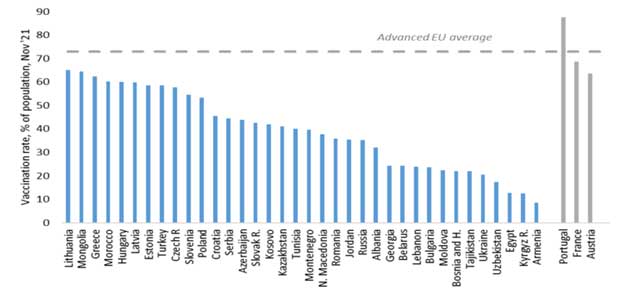What Explains Vaccination Rates in EBRD Regions?

LONDON, Dec 08 (IPS) - Officially reported deaths from Covid-19 started to rise again in autumn 2021 in a number of economies in the EBRD regions. While in advanced economies in Europe the mortality rate has remained low despite the pick-up in Covid-19 cases, in the EBRD regions the mortality and infection rates continued to move in tandem.
Reflecting this, daily Covid-19 deaths per million population were four times higher in the EBRD regions than in advanced Europe as of November 2021.

These patterns may in part reflect differences in vaccination rates. In the EBRD regions, 36 per cent of the population (of all ages) were fully vaccinated by November 15 compared with 72 per cent in advanced economies in Europe.
Aggregate numbers mask significant differences within the EBRD regions, with these shares ranging from 9 per cent in Armenia to 65 per cent in Lithuania.
The regression analysis conducted by Cevat Aksoy, Maxim Chupilkin and Zsoka Koczan in the EBRD’s Office of the Chief Economist links differences in vaccination rates across more than 100 economies (including 28 economies in the EBRD regions) to average beliefs about safety of vaccines.
Attitudes towards vaccines are inferred from Wellcome Global Monitor, a representative survey conducted in 2018.
The analysis also takes into account Covid-19 deaths, income per capita, demographic factors, quality of economic institutions, early availability of vaccines, people’s mobility (movements to transit stations, places of work, retail and recreation and grocery stores compiled by Google Analytics) and other relevant factors.
Since the economic and epidemiological situation may itself be affected by the vaccine rollout, mobility indices and Covid-19 deaths relate to 2020, the period prior to the vaccination campaign.
As could be expected, Covid-19 vaccination rates are typically higher in economies where a larger share of the population believe vaccines to be safe and effective. In the EBRD regions, the prevalence of such beliefs was relatively low before the Covid-19 crisis.
On the supply side, the share of the population that was fully vaccinated in October 2021 is higher in economies with higher number of doctors per capita and where vaccinations started earlier, according to the regression analysis.
On the demand side, a ten percentage point improvement in attitudes toward vaccines increases the vaccination rate by about 2 percentage points. Lower economic mobility in the past is associated with higher vaccination rates – reflecting greater impact of the Covid-19 on livelihoods as well as lower tolerance of health risks reflected in lower mobility of people during the pandemic.
Both on the demand and on the supply side, economies with higher income per capita and better economic institutions tend to have higher vaccination rates, owing to better administrative capacity to roll out vaccination campaigns and higher levels of trust (which tend to be highly correlated with income and institutions).
The measure of economic institutions averages Worldwide Governance Indicators of control of corruption, rule of law, government effectiveness and regulatory quality.
These factors together account for almost 80 per cent of the variation in vaccination rates observed across more than 100 economies. Once various country characteristics are taken into account, vaccination rates in the EBRD regions are somewhat lower than in other economies but the difference (of around 4 percentage points) is not statistically significant.
Favourable attitudes to vaccines, in turn, are higher among individuals who trust their governments. This conclusion emerges from the 2018 Wellcome Global Monitor, a representative survey of over 100,000 individuals in 138 economies.
Indeed, a recent EBRD working paper shows that governments face the challenge of convincing the public that vaccines can be trusted and effectiveness of such communication, in turn, depends on trust in governments themselves.
Respondents were asked whether they viewed vaccines as safe and, separately, effective. The analysis links responses to these questions to individuals’ stated trust in government while taking into account various individual characteristics: residing in an urban area, having a child under 15, gender, employment status, religion, level of education, income quintile, age cohort and the country of residence.
Individuals who trust in their government are around 8 percentage points more likely to have positive attitudes towards vaccination. Further analysis reveals that these relationships are similar among people of different gender, education and age.
The EBRD was created in April 1991 to 'foster the transition towards open market-oriented economies and to promote private and entrepreneurial initiative'.
Alexander Plekhanov is Director, Transition Impact and Global Economics; Cevat Giray Aksoy is Principal Economist; Zsoka Koczan is Associate Director, Senior Economist; and Maxim Chupilkin is Macroeconomic Analyst.
Source: EBRD
Follow @IPSNewsUNBureau
Follow IPS News UN Bureau on Instagram
© Inter Press Service (2021) — All Rights Reserved. Original source: Inter Press Service
 Global Issues
Global Issues